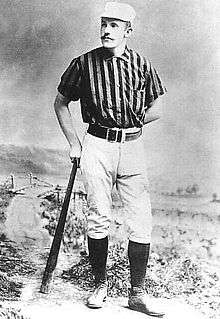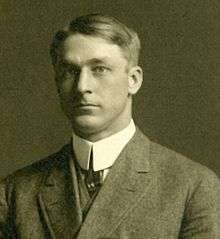Baseball law
Baseball law in the United States refers to the various civil statutes, local ordinances, and court decisions pertaining to the game of baseball and its institutions, as distinguished from the Rules of Baseball, which are a private codification of rules governing the internal workings of baseball games.
Nineteenth-century baseball law
Both the early rules (which act as the laws of the game) and the legal cases surrounding the sport impact the way baseball is played to this day. Documentation of early baseball law exists but has been rarely studied. Nonetheless its presence in legal disputes and records indicate that it was an important part of life prior to the year 1900. In fact, references to baseball are present in 168 legal cases decided before the turn of the twentieth century.[1]
"Blue" laws
In America’s past, “blue” laws prohibited business from taking place on the Sabbath. This was an issue for baseball teams who were playing for spectators on Sundays. On April 30, 1891, Tim O’Rourk and 19 others were the subject of a criminal complaint that pertained to them playing baseball for an audience of about 3,000 in Lincoln Park the previous Sunday. The case of State v. O’Rourk ensued.
It was illegal at the time for anyone over age 14 “engage in sporting” on a Sunday. The penalty for which was “a fine of $20, incarceration for 20 days, or both.” The accused argued that baseball didn’t fall under the category of “sport” and that they were remotely located enough so as not to have offended those observing the Sabbath. The presiding judge dismissed the case on those grounds. However, Chief Justice Maxwell of the Nebraska Supreme Court disagreed.[2]
This case showed that there was a growing class of people willing to depart from tradition and attend a baseball game on a Sunday. It also indicates that there were those who adamantly resisted such change.
Star players

“Free agency” did not exist as it does today in baseball until the 1970s. Instead, players were bound to their teams by something called the “reserve clause. John “Monte” Ward was the first to oppose this in November 1889. He was a star player for the National League’s New York Giants, but was also an author and lawyer.
The “reserve” clause did not specify terms of contract, salary or agreements between player and teams. A judge ultimately ruled that with such fundamental questions left unanswered, the clause could not reasonably be enforced.[3]
This was the first case of many that ruled in favor of the individual player rather than the team. It allowed star players more choices and the ability to use competition to increase their value.
"Jim Crow” ball
Hispanic, black and white Americans have all played baseball since the sport began. In the early days of the sport, integrated teams were not uncommon, with players of color able to play alongside their white counterparts.
However, dating back to as early as 1867, the racism of the post-Civil War era crept into the national pastime.[4] Jim Crow laws were present from Reconstruction into the 1960s and in some instances applied directly to baseball. However, segregation in Major League baseball began to end with the signing and participation of Jackie Robinson with the Brooklyn Dodgers in 1947.
Lawlessness
It cannot be denied that early baseball law was lax compared to the standards of today. As with so many other examples, the development of baseball law mirrors the arc of America’s history at large. Despite the many cases and legal examples, historians Robert M. Jarvis and Phyllis Coleman have suggested that “early baseball was a lawless place, just like America itself.”[5]
Baseball and the legal profession
Innumerable American lawyers and judges have played baseball – amateur or professional – since the game coalesced in the 19th century. Perhaps the iconic legal publication regarding baseball is the article "The Common Law Origins of the Infield Fly Rule", written by Philadelphia attorney William S. Stevens and published in the University of Pennsylvania Law Review in 1975.[6]
Five of the ten Commissioners of Baseball have been lawyers:
.jpg)
| Name | Lifetime | Law School |
|---|---|---|
| Kenesaw Mountain Landis | 1866–1944 | Northwestern University Law School |
| Happy Chandler | 1898–1991 | University of Kentucky College of Law |
| Bowie Kuhn | 1926–2007 | University of Virginia School of Law |
| Fay Vincent | 1938– | Yale University Law School |
| Rob Manfred | 1958– | Harvard University Law School |
Several major league managers are known to have attended law school:

| Name | Lifetime | Law School |
|---|---|---|
| Jim O'Rourke | 1850–1919 | Yale University Law School |
| John Montgomery Ward | 1860–1925 | Columbia University Law School |
| Hughie Jennings | 1869–1928 | Cornell University Law School |
| Miller Huggins | 1878–1929 | University of Cincinnati College of Law |
| Branch Rickey | 1881–1965 | University of Michigan Law School |
| Tony La Russa | 1944– | Florida State University College of Law |
References
- ↑ Jarvis, R. M. and Coleman, P. Early Baseball Law, 45 American Journal of Legal History 117 (2001).
- ↑ Jarvis, R. M. and Coleman, P. Early Baseball Law, 45 American Journal of Legal History 117, 123-24 (2001)
- ↑ Jarvis, R. M. and Coleman, P. Early Baseball Law, 45 American Journal of Legal History 117, 123-24 (2001)
- ↑ George Kirsch, “Blacks, Baseball and the Civil War,” The New York Times (New York, NY), Sept. 23, 2014.
- ↑ Jarvis, R.M. and Coleman, P. Early Baseball Law, 45 American Journal of Legal History 117, 130 (2001)
- ↑ Aside. The Common Law Origins of the Infield Fly Rule, 123 U. Penn. L. Rev. 1474 (1975)
Bibliography
Cases
- American League v. Chase, 86 Misc. 441 (N.Y. Misc. 1914) ("NY Supreme Court Opinion". Retrieved 9 May 2017. )
- City of Anaheim v. Angels Baseball LP (2005) ("California Court of Appeals unpublished decision" (PDF). Archived from the original (PDF) on 20 April 2007. Retrieved 9 May 2017. )
- Federal Baseball Club v. National League, 259 U.S. 200 (1922)
- Flood v. Kuhn, 407 U.S. 258 (1972)
- Gardella v. Chandler, 174 F.2d 919 (2d Cir. 1949) ("Court of Appeals Opinion". Retrieved 9 May 2017. )
- Metropolitan Exhibition Co. v. Ward, 9 N.Y.S. 779 (1890) ("New York Supreme Court Opinion". Retrieved 9 May 2017. )
- Philadelphia Ball Club, Ltd. v. Lajoie, 202 Pa. 210 (1902) ("Pennsylvania Supreme Court Opinion". Retrieved 9 May 2017. )
- Popov v. Hayashi (2002) (California Superior Court)
- Toolson v. New York Yankees, 346 U.S. 356 (1953)
- United States v. Cleveland Indians Baseball Company, 532 U.S. 200 (2001)
Further reading
- Abrams, Roger (1998). Legal Bases: Baseball And The Law. Temple University Press. ISBN 978-1566398909.
- Banner, Stuart (2013). The Baseball Trust. Oxford University Press. ISBN 978-0-19-993029-6.
- Davies, Ross E., It’s No Game: The Practice and Process of the Law in Baseball, and Vice Versa (November 20, 2009). Seton Hall Journal of Sports and Entertainment Law, Vol. 20, No. 2, pp. 249–296, 2010; George Mason Law & Economics Research Paper No. 09-58. Available at SSRN: .
- Ham, Eldon L., Aside the Aside: The True Precedent of Baseball in Law: Law the Residue of Luck -- Or, Who's Not on First? Marquette Sports Law Review, Vol. 13, p. 213, 2003. Available at: .
- Jarvis, R.M. and Coleman, P. Early Baseball Law, American Journal of Legal History, Vol. 45, p. 117, 2001.
- Minan, John H.; Cole, Kevin; editors (2009). The Little White Book of Baseball Law. ABA Book Publishing. ISBN 978-1-60442-100-2.
- Oldfather, Chad M., The Hidden Ball: A Substantive Critique of Baseball Metaphors in Judicial Opinions, Connecticut Law Review, Vol. 27, p. 17, 1994.
- Schiff, Louis H.; Jarvis, Robert M.; editors (2016). Baseball and the Law, Cases and Materials. Carolina Academic Press. ISBN 978-1-61163-502-7.
- Silvia, Thomas V., Baseball as a Source of Judicial Thought and Construction, Michigan Bar Journal, Vol. 78, p. 1296, 1999.
- Waller, Spencer Weber; Cohen, Neil B.; Finkelman, Paul; editors (1995). Baseball and the American Legal Mind. Garland Publishing, Inc. ISBN 0-8153-2057-4.
- Yelnosky, Michael, If You Write It, (S)He Will Come: Judicial Opinions, Metaphors, Baseball, and "The Sex Stuff", Connecticut Law Review, Vol. 28, p. 815, 1996.
- Zelinsky, Aaron S.J., The Supreme Court (of Baseball), Yale Law Journal Online, Vol 121, p. 143, 2011.
- Zollmann, Carl, Baseball Peonage, Marquette Law Review, Vol. 24, p. 139, 1940. Available at: .